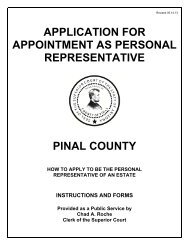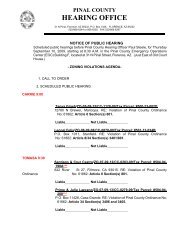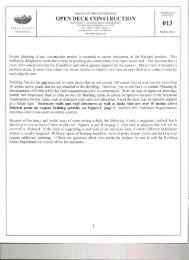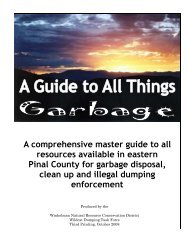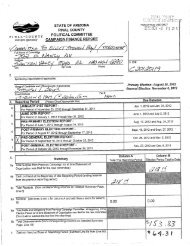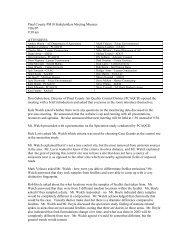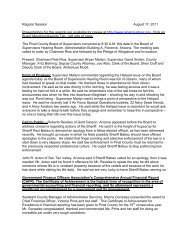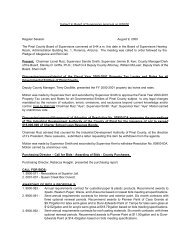Wood Burning Handbook - Pinal County
Wood Burning Handbook - Pinal County
Wood Burning Handbook - Pinal County
Create successful ePaper yourself
Turn your PDF publications into a flip-book with our unique Google optimized e-Paper software.
What Happens when <strong>Wood</strong> Burns?<br />
Complete combustion gives off light, heat, and the gases carbon dioxide and water vapor. Because<br />
when wood burns complete combustion does not occur, it also produces wood smoke, which contains<br />
the following major air pollutions, regulated by State and federal rules because of their known health effects:<br />
Carbon Monoxide (CO) – An odorless, colorless gas, produced in large<br />
amounts by burning wood with insufficient air. CO reduces the blood’s<br />
ability to supply oxygen to body tissues, and can cause stress on your<br />
heart and reduce your ability to exercise. Exposure to CO can cause longterm<br />
health problems, dizziness, confusion, severe headache, unconsciousness<br />
and even death. Those most at risk from CO poisoning are the<br />
unborn child, and people with anemia, heart, circulatory or lung disease.<br />
Oxides of Nitrogen (NOx) – NOx impairs the respiratory system and its<br />
ability to fight infection. NOx also combines with VOCs to make ozone and<br />
with water vapor to form acid rain or acid fog.<br />
Volatile Organic Compounds (VOCs) – Evaporated carbon compounds<br />
which react with NOx in sunlight to form ozone (photochemical smog).<br />
Ozone injures the lungs and makes breathing difficult, especially in children<br />
and exercising adults. NOx and VOCs also form particulate matter<br />
through reactions in the atmosphere.<br />
Toxic Pollutants - <strong>Wood</strong> smoke also contains VOCs which include toxic and/or<br />
cancer-causing substances, such as benzene, formaldehyde and benzo-apyrene,<br />
a polycyclic aromatic hydrocarbon (PAH). Manufactured fireplace logs,<br />
for instance, are not recommended for burning because they produce toxic<br />
fumes, including PCBs (polychlorinated biphenyls). Researchers are now studying<br />
these and other smoke products to learn more about their effects on human<br />
health.<br />
Particulate Matter less than 10 microns in diameter (PM10) are very small droplets of condensed<br />
organic vapors of wood tar and gases. These particles are a result of unburned fuel and have a diameter<br />
of 10 microns or smaller (the diameter of a human hair is about 50 to 100 microns), which allows<br />
them to be inhaled into the lungs. Exposure to PM10 aggravates a number of respiratory illnesses.<br />
PM10 includes a smaller group of particles called<br />
PM2.5, particles with diameters of 2.5 microns<br />
and less. These finer particles pose an increased<br />
health risk because they can lodge deep in the<br />
lungs and contain substances that are particularly<br />
harmful to human health, contributing to lung diseases<br />
and cancer. Exposure to PM2.5 may even<br />
cause early death in people with existing heart<br />
and lung disease.<br />
4



